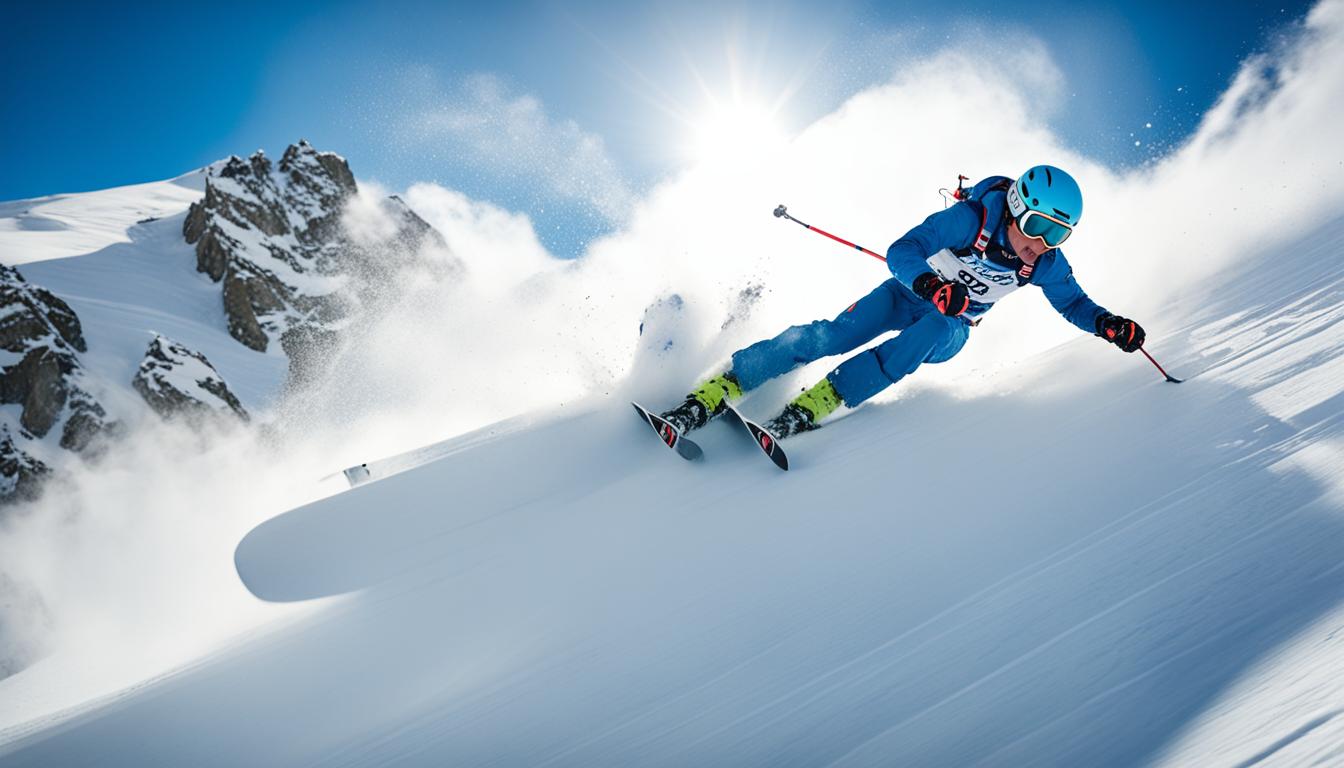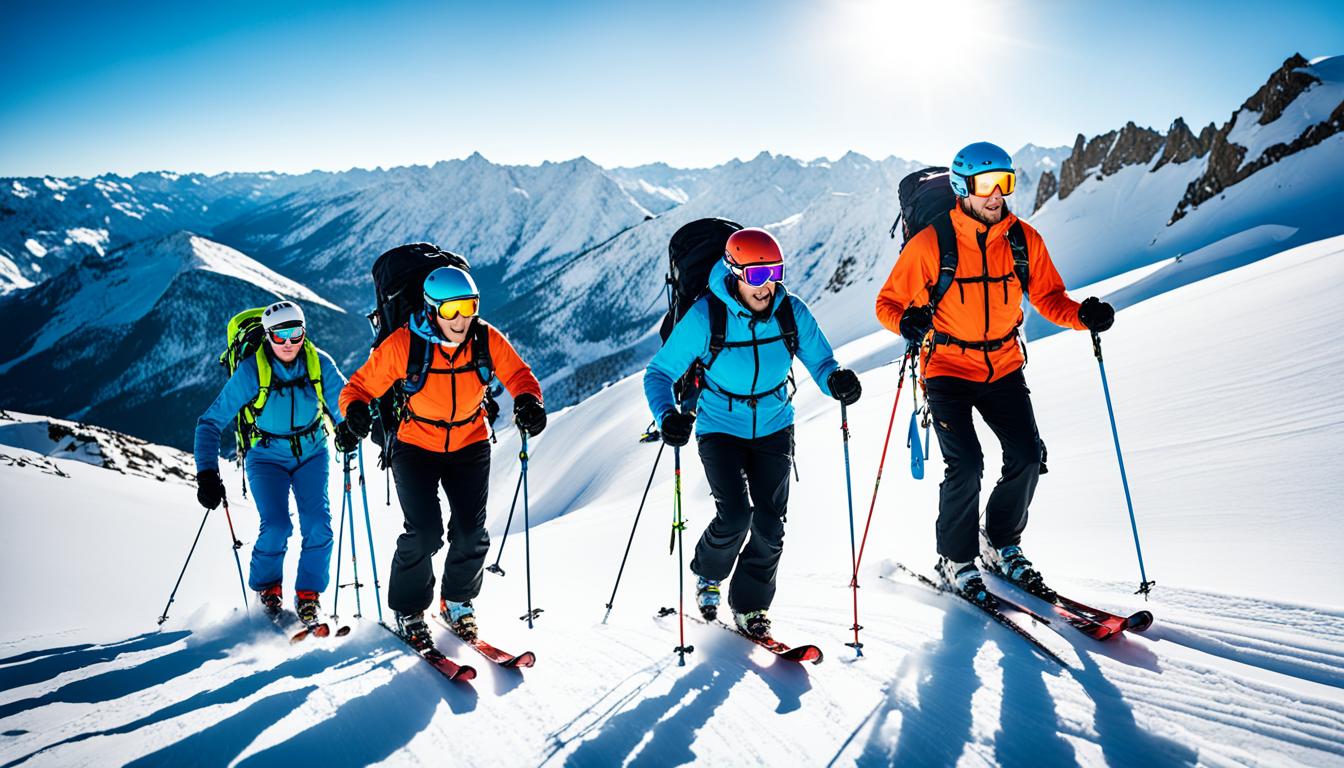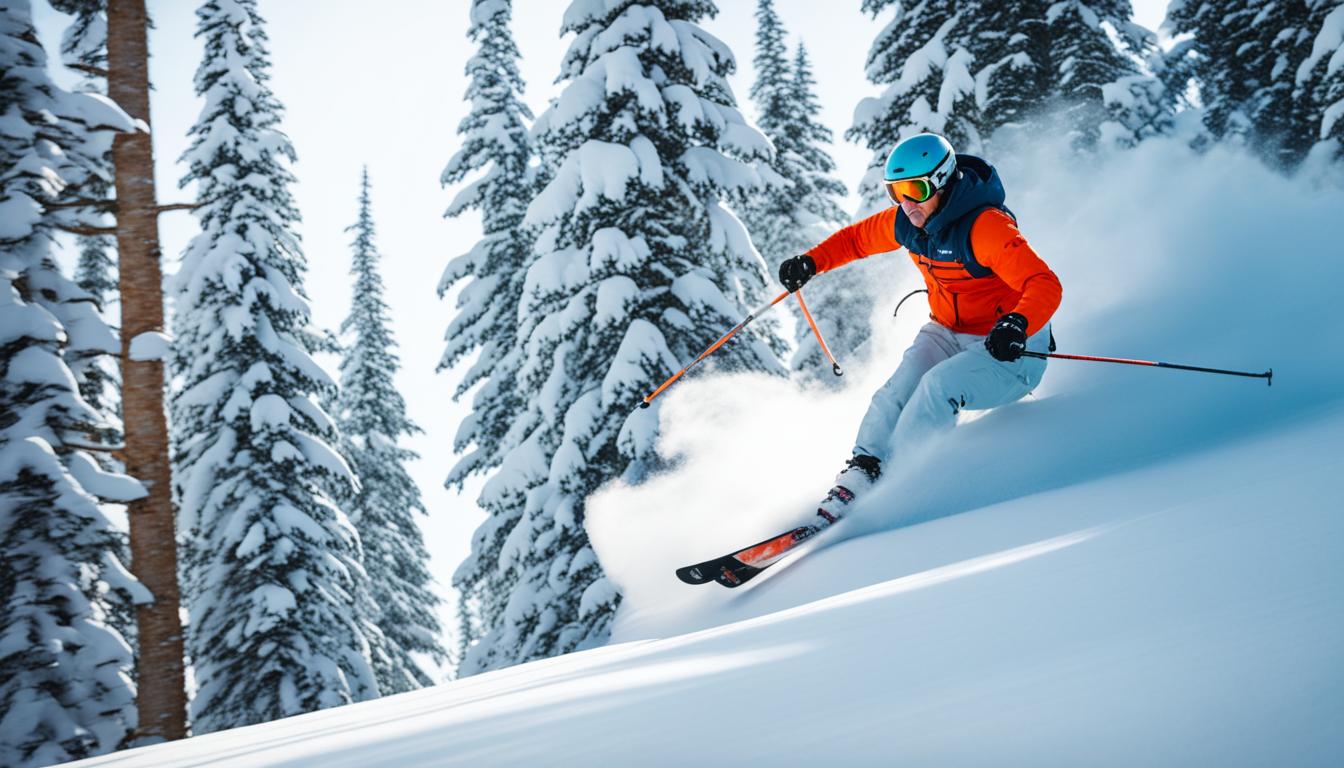Ski racing is an exhilarating sport that requires advanced skills and techniques to achieve high speeds and maintain control on the slopes. In this article, we will explore various racing and speed techniques for advanced skiers to help elevate their skills and improve their performance. These techniques have been compiled from reputable sources in the skiing industry, including tips from experienced ski racers and ski instructors. Whether you are a competitive racer or simply looking to improve your speed and agility on the slopes, these techniques will provide valuable insights and strategies to help you reach your goals.
Key Takeaways:
- Invest in ski racing drills and speed training to enhance your racing skills.
- Improve your ski technique by focusing on core strength, leg strength, and flexibility.
- Choose the right equipment, including ski length, type, and maintenance, for optimal speed on the slopes.
- Perfect your starting technique, gate navigation, and line selection for faster starts.
- Master the art of tucking to maximize your speed and control on the racecourse.
Getting Fit for Speed
One of the key factors in skiing at high speeds is being physically fit. To excel in racing, it is crucial to develop ski fitness, core strength, leg strength, flexibility, and speed training. Building a strong foundation in these areas will provide the stability and control necessary to handle the demands of racing and enhance overall skiing skills.
Here are some important elements to focus on:
1. Ski Fitness
Ski fitness involves training your body to endure the physical demands of skiing at high speeds. This includes cardiovascular exercises to improve endurance and stamina, as well as specific ski-related exercises to target the muscles used in skiing. In addition, cross-training activities such as cycling, running, or swimming can help improve overall fitness levels and support ski-specific training.
2. Core Strength
A strong core is essential for maintaining stability and balance while skiing. Engaging in exercises that target the abdominal, back, and pelvic muscles can help develop core strength. Planks, Russian twists, and leg raises are effective exercises for strengthening the core.
3. Leg Strength
Strong legs are essential for generating power and control on the slopes. Exercises such as squats, lunges, and leg presses can help build leg strength. Additionally, incorporating plyometric exercises like box jumps and lateral hops can improve explosiveness and quickness, which are crucial for fast skiing.
4. Flexibility
Flexibility plays a vital role in executing precise turns and absorbing vibrations at high speeds. Stretching exercises that target the legs, hips, and lower back can help improve flexibility and range of motion. Incorporating dynamic stretching, such as leg swings and arm circles, before skiing sessions can help prepare the muscles for action.
5. Speed Training
Specific speed training drills can help improve agility, reaction time, and overall ski performance. These drills may include slalom exercises, timed runs, and interval training. Working with a ski coach or trainer can provide personalized speed training programs tailored to your specific needs and goals.
“Physical fitness is the foundation of skiing at high speeds. By focusing on ski fitness, core strength, leg strength, flexibility, and speed training, we can enhance our racing performance and elevate our skiing skills to new heights.”
By incorporating these elements into your fitness regimen, you can effectively improve your ski fitness and enhance your racing potential. Remember, achieving speed and control on the slopes requires a balance of physical fitness, technique, and mental focus. Stay disciplined, train consistently, and enjoy the rewards of your hard work and dedication.
Exercise Routine to Improve Ski Fitness and Performance
| Exercise | Target Muscles | Repetitions | Sets |
|---|---|---|---|
| Squats | Quadriceps, Hamstrings, Glutes | 12-15 | 3-4 |
| Lunges | Quadriceps, Hamstrings, Glutes | 10-12 (each leg) | 3-4 |
| Planks | Core muscles | 30-60 seconds | 3-4 |
| Russian Twists | Obliques, Core muscles | 12-15 (each side) | 3-4 |
| Leg Raises | Lower Abdominals | 12-15 | 3-4 |
| Box Jumps | Legs, Glutes | 8-10 | 3-4 |
| Lateral Hops | Legs, Hips | 8-10 | 3-4 |
Equipment for Speed
Choosing the right equipment is essential for achieving maximum speed on the slopes. For racing, it is important to select skis that are appropriate for speed events, such as super G or downhill. Longer skis provide more stability at high speeds, while the choice of ski type and sidecut radius can impact turning ability.
“Longer skis provide more stability at high speeds, while the choice of ski type and sidecut radius can impact turning ability.”
When it comes to ski length, the general rule is that shorter skis are easier to maneuver, while longer skis offer better stability at high speeds. Advanced skiers looking for speed should opt for skis that are longer than their height. Keep in mind that ski length can vary depending on factors such as personal preference, ski type, and skiing ability.
Ski Types for Speed Events
For speed events, such as super G or downhill, specialized skis designed for racing are preferred. These skis are typically stiffer, providing better power transmission and edge hold. They are designed to handle higher speeds and offer superior stability. The specific ski type you choose should be based on your racing discipline and individual preference.
Turning Ability and Sidecut Radius
The sidecut radius of a ski refers to the curve of its edges, affecting its turning ability. Skis with smaller sidecut radii make shorter, quicker turns, while skis with larger sidecut radii make wider, smoother turns. When it comes to speed, skis with a larger sidecut radius are generally preferred, as they offer better stability and allow for smoother, more controlled turns at high speeds.
| Ski Type | Sidecut Radius | Turning Ability |
|---|---|---|
| Slalom skis | 10-12 meters | Quick, short turns |
| Giant slalom skis | 17-23 meters | Longer, sweeping turns |
| Downhill skis | 30+ meters | Wide, stable turns |
Regular ski maintenance is crucial for ensuring optimal performance and speed. Proper waxing techniques play a significant role in reducing friction and enhancing glide. Prior to races, it is recommended to apply multiple coats of wax to optimize the skis’ speed. Additionally, regular ski maintenance, such as edge tuning and base repairs, keeps your skis in top condition for maximum speed and control on the slopes.
Remember, the right equipment and proper maintenance can make a difference in your speed and overall skiing performance. Now that you know what to look for in terms of ski length, ski type, sidecut radius, and maintenance, you can gear up and hit the slopes with confidence.
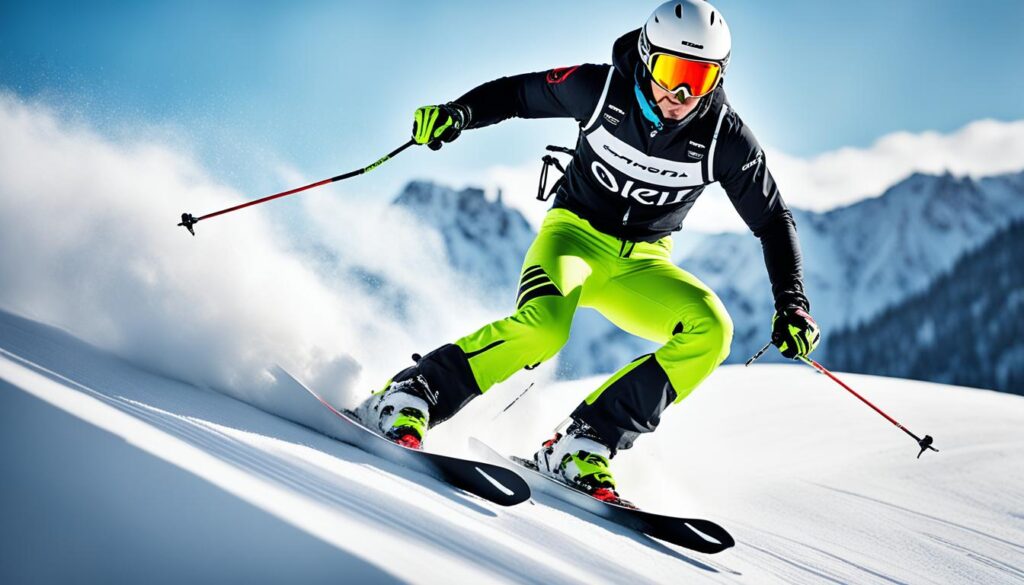
Techniques for Speedy Starts
A fast start is essential for gaining an advantage in a race. Perfecting your starting technique, such as utilizing powerful pushes and efficient tuck positions, can help shave off valuable seconds. Navigating gates and selecting the optimal line through a course is another key aspect of achieving high speeds. Understanding the terrain and anticipating changes in the racecourse can make a significant difference in your racing performance.
Tips for a Faster Start
- Focus on powerful pushes: When the starting gate opens, exert maximum force with your poles and legs to propel yourself forward. This burst of power will give you a head start and set a quick pace for the rest of the race.
- Master the tuck position: As you gain momentum, assume a streamlined tuck position to minimize air resistance. Keep your body low and compact, with your hands resting on your shins and your elbows tucked in.
- Efficient gate navigation: Approach each gate with precision, aiming to pass as close to the gate as possible without hitting it. Maintain a smooth line through the gates to minimize any unnecessary turns or loss of speed.
- Strategize line selection: Study the racecourse beforehand and identify the fastest line based on the terrain and gate placement. Anticipate changes in the racecourse, such as sharp turns or bumps, and adjust your line accordingly to maintain your speed and control.
Remember, a fast start sets the tone for the entire race. By focusing on your starting technique, tuck position, gate navigation, and line selection, you can gain a competitive edge and maximize your speed on the slopes.
Now that you have learned the key techniques for a speedy start, let’s move on to mastering the art of tucking for maximum speed and control. But before that, take a moment to visualize the excitement of a fast start with the following image:
Visualizing success can help you stay motivated and focused as you continue your pursuit of mastering ski racing techniques.
The Art of Tucking
Mastering the art of tucking is crucial for achieving maximum speed on a racecourse. When we talk about tucking, we refer to the position skiers assume to reduce air resistance and maximize aerodynamics.
So, what exactly is the proper tuck position? It involves keeping your feet under the shoulders and your hands in front of your face. This body alignment not only enhances aerodynamics but also minimizes drag, allowing you to slice through the air effortlessly.
Weight distribution is another crucial aspect of tucking. By distributing your weight correctly, you can optimize control and increase your speed. Adjusting your tuck position to match the course terrain is essential. For example, when encountering steep sections, shifting your weight slightly forward can help maintain stability and control. Similarly, on flat sections, shifting your weight slightly back can help generate speed.
By mastering the art of tucking, advanced skiers can unlock their full potential and reach exhilarating speeds on the slopes. So, next time you’re racing down the hill, remember to assume the perfect tuck position and immerse yourself in the thrill of speed.
Common Mistakes to Avoid when Tucking
| Mistake | Impact | Correction |
|---|---|---|
| Tucking too early | Loss of control and speed due to premature tuck position | Wait until you’ve gained momentum before assuming the tuck position. |
| Tucking too late | Missed opportunity to optimize aerodynamics and speed | Start tucking as soon as you reach a suitable speed and terrain. |
| Poor weight distribution | Instability and compromised control | Ensure equal weight distribution between your skis and adjust as needed based on the terrain. |
| Incorrect body alignment | Increased drag and reduced aerodynamics | Maintain a streamlined position with your feet under your shoulders and your hands in front of your face. |
Advanced Racing Techniques
In addition to fitness, equipment, and tucking, advanced skiers should focus on refining their racing techniques. By mastering the art of carving turns and maintaining gate precision, skiers can gain a competitive edge on the racecourse. Developing effective racing strategies and finishing strong are also pivotal for achieving faster times and securing victory in each race.
Carving Turns
Carving turns is a vital skill for advanced skiers aiming for speed and control. By utilizing the edges of their skis to grip the snow, skiers can maintain precise control and initiate quick turns. This allows for smoother transitions between turns and enables skiers to maintain momentum throughout the race. Practicing carving turns on various terrain and in different snow conditions will enhance the ability to adapt and navigate racecourses with ease.
Gate Precision
Precision is key when it comes to successfully navigating gates on the racecourse. Skiers must aim to ski as close to each gate as possible, minimizing the time between turns and reducing the distance traveled. Maintaining gate precision requires excellent balance, agility, and anticipation. By training on slalom or giant slalom courses with strategically placed gates, skiers can refine their technique and improve their racing performance.
Racing Strategy
“In ski racing, a well-executed strategy is just as important as physical skill. Before each race, study the course map, taking note of any challenging sections or crucial turning points. Develop a plan to tackle these sections, considering the best lines and tactics to gain speed. Remember to be adaptable and make quick decisions during the race based on the conditions and the performance of fellow competitors.” – Jane Miller, Professional Ski Racer
Finishing Strong
The final moments of a race can be decisive in determining the overall outcome. A strong finish is essential for securing the best possible time and standing. Skiers should focus on maintaining speed, power, and technique all the way to the finish line. Building endurance through specific training exercises, such as interval training and high-intensity sprinting, will help skiers finish the race strong and maximize their performance.
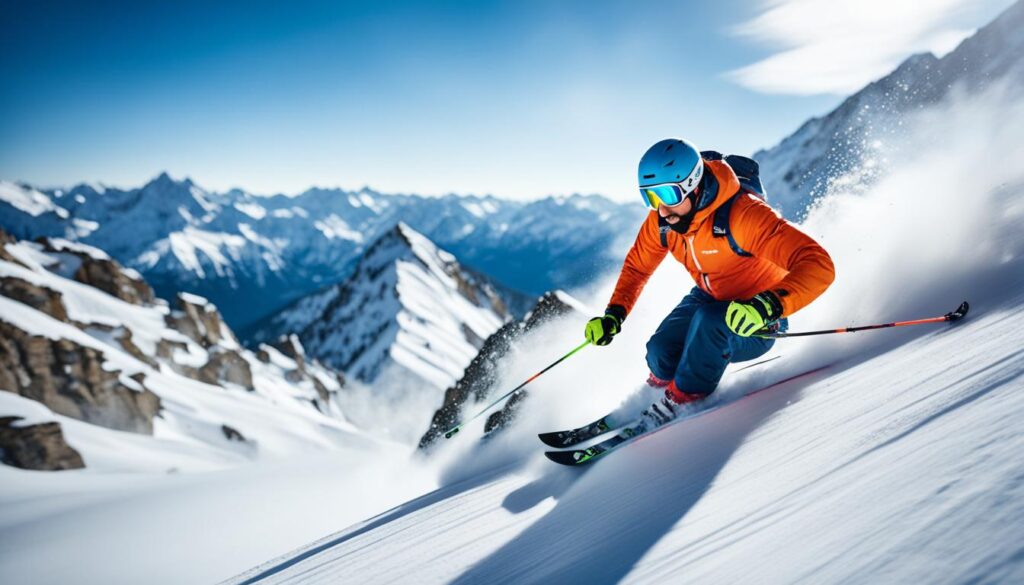
| Technique | Description |
|---|---|
| Carving Turns | Utilize the edges of the skis to grip the snow and initiate precise turns, maintaining control and speed. |
| Gate Precision | Ski as close to each gate as possible, minimizing the time and distance traveled between turns. |
| Racing Strategy | Develop a well-thought-out plan based on course conditions and competitors’ performance to optimize speed and efficiency. |
| Finishing Strong | Maintain speed, power, and technique until the finish line to secure the best possible time and standing. |
Conclusion
Racing and speed techniques are essential for advanced skiers seeking to enhance their skiing performance and improve their speed on the slopes. By focusing on fitness, selecting the right equipment, mastering the art of tucking, and refining racing techniques, skiers can elevate their skills to new heights. These techniques, when incorporated into training and practice sessions, can help advanced skiers become true masters of the sport.
Whether you are a competitive racer or simply enjoy the exhilaration of skiing at high speeds, these techniques can make a significant difference in your skiing performance. By prioritizing fitness and building core strength and leg strength, you will have the stability and control needed to handle the demands of racing. Choosing the right equipment, such as longer skis for better stability and proper maintenance for optimal speed, is also vital. Masters of the sport know how to tuck properly, maintaining an aerodynamic position to minimize drag and maximize speed on the racecourse.
Furthermore, advanced skiers should focus on refining their racing techniques, including carving precise turns, maintaining gate precision, developing effective racing strategies, and finishing strong. These skills will help you achieve faster times and improve your overall racing performance. As you incorporate these techniques into your skiing practice, you will experience the thrill and satisfaction of unleashing your full potential as a skier.
So, lace up your boots, hit the slopes, and let the adrenaline of racing propel you forward as you strive for personal growth and excellence. With dedication, practice, and the implementation of these racing and speed techniques, advanced skiers like you can reach new levels of performance and become masters of the sport. Happy skiing!
FAQ
What are some racing and speed techniques for advanced skiers?
Advanced skiers can improve their racing performance by focusing on fitness, selecting the right equipment, mastering tucking, and refining racing techniques.
How can I get fit for speed skiing?
Building core strength and leg strength, maintaining flexibility, and incorporating speed training drills into your fitness regimen can help improve your racing performance.
What equipment should I use for speed skiing?
For speed events like super G or downhill, choose longer skis that provide stability at high speeds. Regular ski maintenance, proper waxing techniques, and multiple wax applications before races are also important for optimal glide and speed.
What techniques can help me with speedy starts in a race?
Perfecting your starting technique, such as utilizing powerful pushes and efficient tuck positions, can help you gain an advantage in a race. Navigating gates and selecting the optimal line through a course are also key aspects of achieving high speeds.
How can I improve my tucking technique for maximum speed?
Maintaining a proper tuck position with feet under the shoulders and hands in front of the face enhances aerodynamics and minimizes drag. Distributing weight correctly and adapting the tuck position to the course terrain allows for better control and increased speed.
What are some advanced racing techniques I should focus on?
Advanced skiers should focus on carving precise turns, maintaining gate precision, and developing effective racing strategies. Having a strong finish is also crucial for achieving faster times in a race.
How can racing and speed techniques improve my skiing performance?
Incorporating racing and speed techniques into your training and practice sessions can help improve your speed and agility on the slopes, elevating your overall skiing performance.

